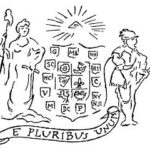“In God We Trust” has been the official national motto since 1956, but the motto E Pluribus Unum dates back to the founding of the American nation. In the 1770s and ’80s, according to historian Thomas Foster, Congress rejected the kind of theistic motto that the current Congress reaffirmed just last week.
Last week Congress voted to reaffirm “In God We Trust” as the national motto of the United States. Rep. Randy Forbes, R-Va., who introduced the measure, argued that we would be following “our predecessors” by declaring a national trust in God. Last year, he and the Congressional Prayer Caucus criticized President Obama when he “falsely proclaimed” in a speech in Jakarta that the national motto is E Pluribus Unum – “from many, one.”
The conservatives who criticized Obama and who claim the mantel of the Founding Fathers are mistaken on both counts. Although “In God We Trust” is the official motto, E Pluribus Unum has long been acknowledged as a de facto national motto. After all, it is on the Great Seal of the United States, which was adopted in 1782. Moreover, in the 1770s and ’80s Congress opposed a theistic motto for the nation, and many of the founders worked hard to prevent one from being established.

In July 1776, almost immediately after signing the Declaration of Independence, John Adams, Benjamin Franklin, and Thomas Jefferson were tasked with designing a seal and motto for the new nation. John Adams proposed the “Choice of Hercules” as the image for the seal, preferring a secular allegory to represent his belief that individuals should lead moral lives and devote themselves to civic duty. Benjamin Franklin proposed the image of Moses dividing the Red Sea, overwhelming Pharaoh and his chariot – which he believed captured the principle that “Rebellion to Tyrants is Obedience to God.” Thomas Jefferson, who later created his own Bible by cutting out all mentions of the miracles of Jesus Christ, envisioned images of the “Children of Israel” and the Saxon Chiefs “whose Political Principles and Form of Government We have assumed.”
Each of these ideas was rejected. Years (and many committees) later, Congress approved the final design still in use today, of an American bald eagle clutching thirteen arrows in one talon and an olive branch in the other.
Only the motto E Pluribus Unum (“from many, one”) survived from the committee on which Adams, Jefferson, and Franklin had served. The current motto, “In God We Trust,” was developed by a later generation. Used on coinage during the Civil War, it was made the official national motto in 1956, at the height of the Cold War, to signal opposition to the feared secularizing ideology of communism.
In other words, “In God We Trust” is a legacy of founders, but not the founders of the nation. As the official national motto, it is a legacy of the founders of modern American conservatism – a legacy reaffirmed by the current Congress.
Thomas A. Foster is Chair of the Department of History at DePaul University. He is the editor of New Men: Manliness in Early America (NYU Press 2011) and a writer for the History News Service.
[Full version of this article appeared in the History News Service.]
